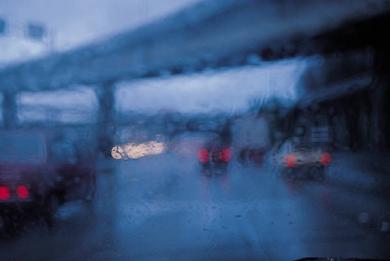The weather in the South can be unpredictable. Storms can pop-up out of nowhere. Motorcycle riding in the rain safely is a matter of dressing properly, understanding traction, making sure you can see, and making sure that you are seen.
Gear-Up:
**Image to the right taken from the Motorcycle Superstore website.
Seeing and being seen are bigger concerns than traction.
The key element in being able to enjoy a day riding in the rain is good rain gear. These days virtually all rain-suits from
reputable motorcycle-accessory firms will keep you dry in a torrent. The factors that set some apart are ease of entry, conspicuous colors, and comfort.
There is nothing like a hard, biting rainstorm to convince someone of the advantage of a full-coverage helmet. Rain drops can hurt at 65 mph, so you want your face covered. You may also not want the dark lenses of your sun glasses. A full-coverage face-shield on an open-face helmet will block the rain drops, but lets more water get onto your face and drip down the inside of the shield of a full-face helmet.
Staying comfortable is important. Furthermore, if you get wet and cold, fatigue erodes that mental edge you need to stay ahead of the traffic around you.
Stick Like Glue:
Once you have dressed for the rain, you have only two motorcycle safety issues to confront: traction and vision. Traction seems to be the primary concern for most riders, usually because they aren’t sure how much grip they have available. While some surfaces–metal fixtures such as manhole covers and bridge gratings, painted areas, and places where built-up oil and grease have not washed off–become much slipperier when wet, you can actually call on a surprising amount of traction on clean asphalt or concrete.
How much? The easiest way to test traction is to feel for it with your rear brake.
Assuming you know how much deceleration you can develop on dry pavement before the rear tire breaks loose, you have a gauge of what’s available if you repeat the test when the road is wet. This also assumes that you have a reasonable amount (say 3/16 of an inch) of tread depth. If you do this at moderate speeds on a flat, straight road, it won’t become a thrill ride. Avoid locking up the rear wheel on a steeply crowned road, where it will tend to slide downhill and out of line.
You also can do a couple of things to improve traction. Premium aftermarket tires are virtually certain to give better wet-road grip than original-equipment tires. Also, a slight increase in tire pressure also improves the wet-weather traction of any tire. Increasing your tire pressure by five p.s.i. or less helps to cut through the film of water and prevent hydroplaning. Just don’t take that to mean you can venture out on bald tires with a bit more air in them.
Some situations should be confronted with extreme caution. Railroad tracks are extremely dangerous when wet. The standard advice is to try to cross railroad or other metal tracks at a right angle, even in the dry. When they are wet, this is imperative.
Otherwise, you risk having the tire slip into the groove alongside the track, which will immediately ruin your whole day.
Other large metal road surfaces or metal sections running parallel to your direction of travel — some expansion joints, for example — are equally hazardous and should be approached cautiously and upright. A thin strip of metal can usually be crossed while leaned over mildly; tires slip then catch again after crossing. However, a large metal surface such as a bridge grate, a manhole cover or a cattle guard, may permit the tire to slip too much to recover traction. Painted surfaces can be almost as slippery as metal.
Did you find these motorcycle safety tips helpful? If so, share them with your friends on Facebook.



